Tomato Charu Recipe
Rasams are a popular clear soup-like dish that is prevalent in all of South India. Different states have their own versions. I have shared the recipe of Tomato Charu on this post, which is the Andhra version of rasam made with tomatoes, spices and herbs. This is a spicy vegan recipe that is quick to make. But is full of flavors and pairs the best with steamed rice. Have it piping hot.

About Tomato Charu
Rasam is called as ‘charu’ in Andhra Pradesh and ‘saaru’ in Karnataka. There are varieties of charu that are there, out of which, Tomato Charu is one of the most common ones.
Although, each household may have a significant way of making it. The recipe that I have shared here, is the way I prepare it at my home.
When preparing Tomato Charu, I typically opt to blend the tomatoes into a smooth puree. While you can also crush or chop the tomatoes, I prefer the pureed consistency.
Additionally, you can strain the tomato puree, if desired. A small amount of tamarind is included in this recipe, although it’s okay to omit it if unavailable. However, it is because of the tamarind, there’s a certain uniqueness in the flavor of the dish.
Tamarind simply make the tomato charu a bit more tart, than what it would be with only the tomatoes included in the recipe.
For this Tomato Charu recipe, you have the option to blanch the tomatoes before pureeing them, but it’s also fine to skip this step.
I usually make this dish for a quick lunch and dinner, so I do not blanch the tomatoes. The spice powders that I use in this recipe are turmeric powder, red chili powder and rasam powder. Rasam Powder adds a classic touch to the recipe.
Apart from all the above, there is a tempering that is a must for this Tomato Charu. For which, I use mustard seeds, cumin seeds, asafoetida, curry leaves and dried red chilies.
Adding this tempering to the charu, brings all the flavors together and makes for an absolutely palatable dish.

Step-by-Step Guide
How to make Tomato Charu
1. Soak 1 teaspoon tamarind in ¼ cup hot water for 15 to 20 minutes.
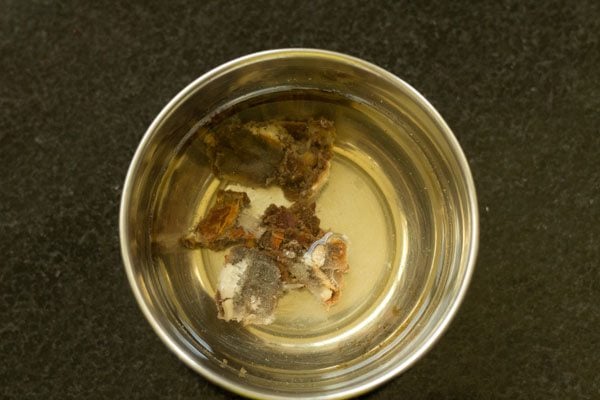
2. Then, squeeze the tamarind and extract the pulp. Set aside the tamarind extract.
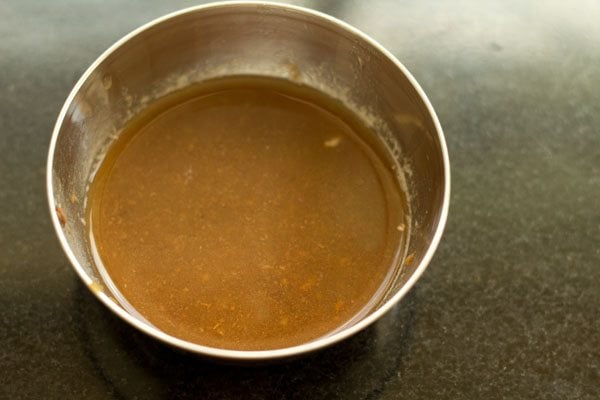
Make Tomato Puree
3. When the tamarind is soaking, chop 250 grams tomato (4 to 5 medium tomatoes).
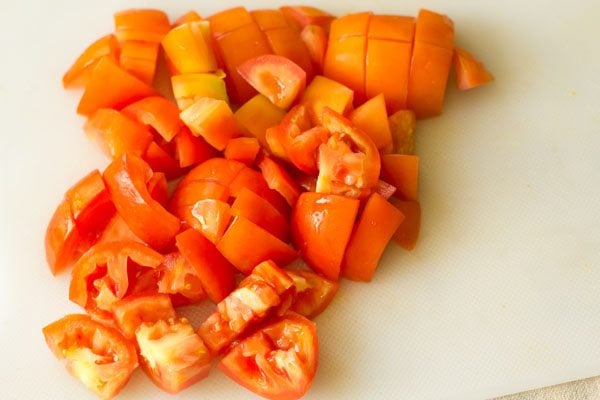
4. Add them along with their juices from the chopping board to a blender jar.

5. Blend to a fine, smooth puree.
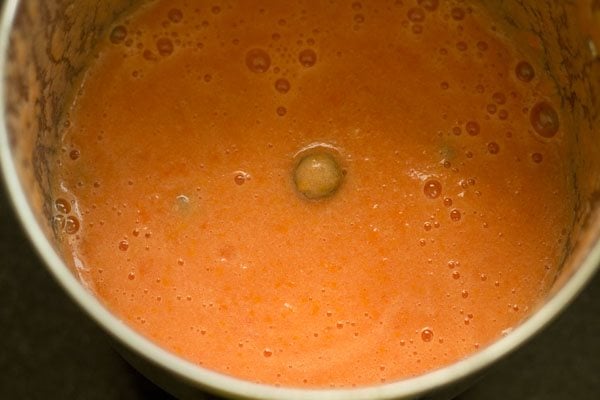
Cook Tomato Puree
6. Transfer the tomato puree in a pan or pot.
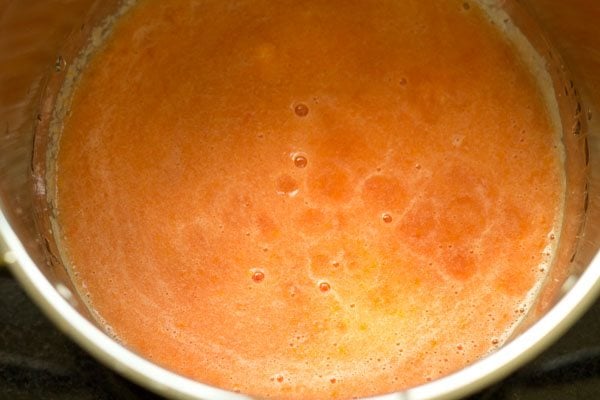
7. Now, add ¼ teaspoon turmeric powder and ½ teaspoon red chili powder.
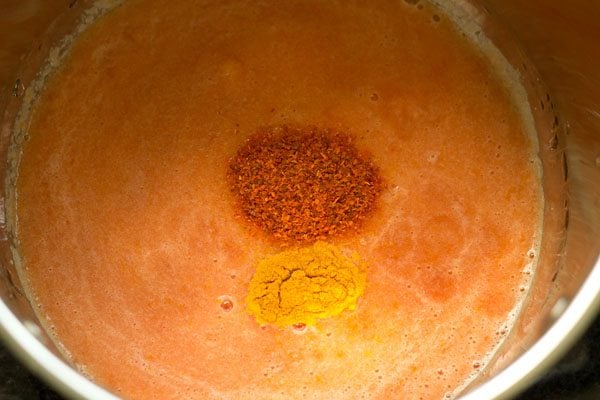
8. Then, add 2 cups water and mix very well.

9. Keep the pan on the stovetop and cover with a lid. On low to medium heat, simmer the tomato mixture for 3 to 4 minutes.
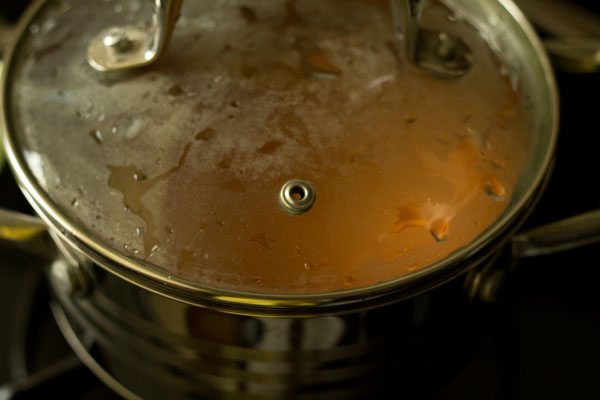
10. Then, remove the lid and continue to simmer for 1 to 2 minutes or until the raw flavors of the tomatoes are not there.
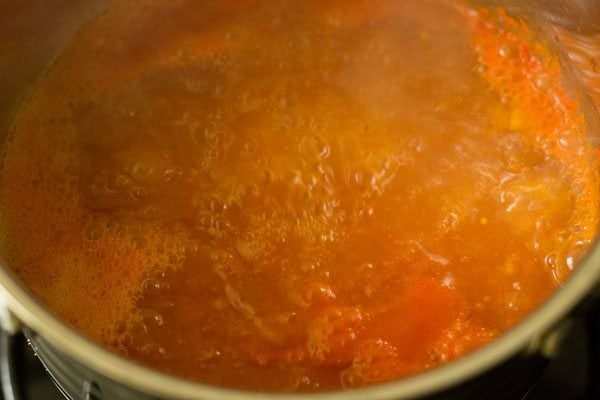
Add Tamarind Pulp
11. Next, using a small strainer, strain the tamarind pulp over the tomato broth carefully, taking care that the steam does not touch your hands.
Or you can turn off the heat and add the tamarind pulp. You can also add the tamarind pulp directly without using a strainer.
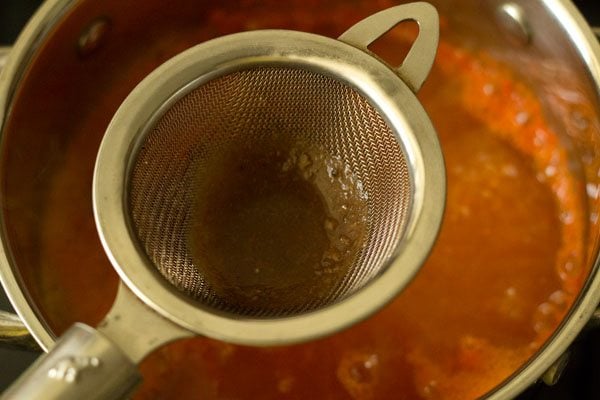
12. Mix well.
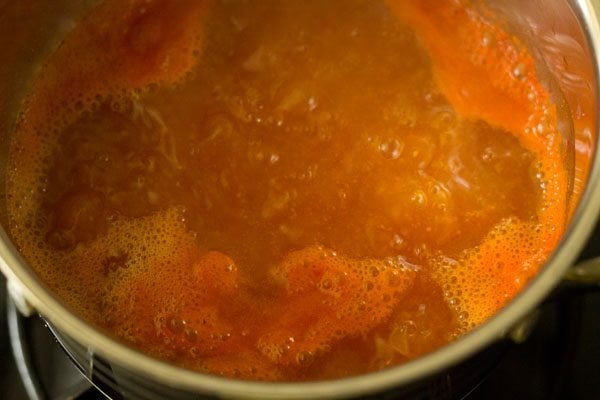
Add Seasonings & Rasam Powder
13. Next, add salt as per taste. Then, simmer for 4 to 5 minutes.

14. Then, add 2 teaspoons Rasam Powder. Cook further for 3 to 4 minutes.
If you do not have rasam powder, you can skip it, but the taste of the charu will be different.
A bit of jaggery (about ½ to 1 teaspoon) can also be added to balance the sourness of tomatoes.

15. After simmering for 3 to 4 minutes, turn off the heat. Cover pan with a lid and set aside.

Temper & Make Tomato Charu
16. Heat 1 tablespoon oil in a small pan or tadka pan. Add ½ teaspoon mustard seeds and let them crackle.

17. Then, add ½ teaspoon cumin seeds and let them splutter.
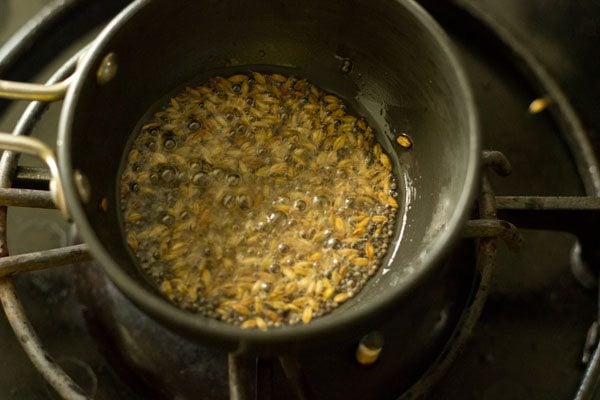
18. Next, add 2 dried red chilies and 10 to 12 curry leaves along with a generous pinch of asafoetida (hing).
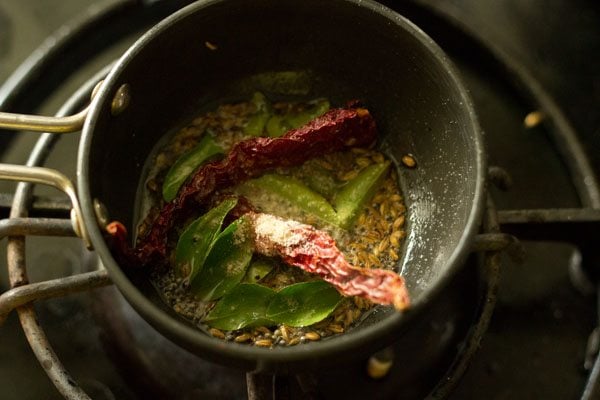
19. Fry until the red chilies change color and curry leaves become crisp. Turn off the heat and add this entire tempering mixture to the Tomato Charu.
Cover the pan for 4 to 5 minutes so that the tempering flavors infuse into the charu.

20. Then, remove the lid and add 2 to 3 tablespoons chopped coriander leaves.

22. Serve the Andhra-style Tomato Charu with steamed rice or you can drink it as a soup.
Store leftovers in the refrigerator for a day. Reheat until warm or lightly heat in a sauce pan.

Expert Tips
- Choice of tomatoes: Use fresh and ripe tomatoes for the best flavor.
- Tomato preparation: Chop the tomatoes finely or blend them into a puree, depending on your preference. This will give the charu a smooth consistency. You can also crush the tomatoes.
- Adding spices: Adjust the quantity of spices like turmeric powder, red chili powder, and salt according to your taste. Andhra-style charu tends to be slightly tangy and spicy, so balance these flavors accordingly.
- Consistency of the dish: The consistency of the charu can vary from thin to slightly thick. If you prefer a thicker consistency, you can add a little bit of mashed dal (cooked lentils) to the charu.
- Garnishing Tomato Charu: Fresh coriander leaves is a must and enhances the flavor and freshness of the charu.
Please be sure to rate the recipe in the recipe card or leave a comment below if you have made it. For more vegetarian inspirations, Sign Up for my emails or follow me on Instagram, Youtube, Facebook, Pinterest or Twitter.
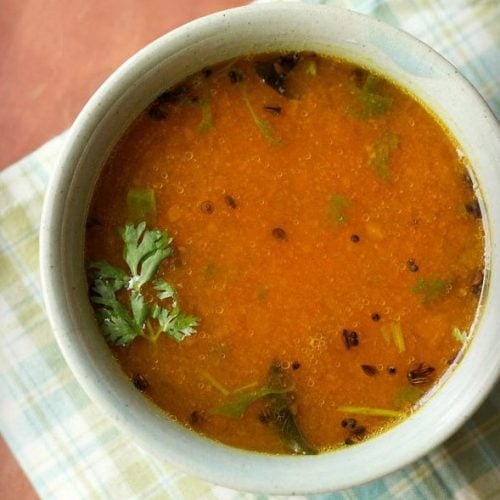
Tomato Charu Recipe
Tomato Charu is the Andhra version of a spicy tomato rasam that is made with fresh tomatoes, tamarind, spices, rasam powder and herbs. It is best paired with steamed rice or can be served as a soup or appetizer drink.
Prep Time 15 minutes
Cook Time 15 minutes
Total Time 30 minutes
For tamarind extract
Main ingredients
For tempering
Preparation
Soak tamarind in hot water for 15 to 20 minutes.
Then squeeze the tamarind and extract the pulp. Set aside the tamarind extract.
When the tamarind is soaking, chop the tomatoes.
Add them along with their juices in a blender jar.
Blend to smooth puree.
Transfer the tomato puree in a pan or pot.
Now add turmeric powder and red chilli powder.
Then add water and mix very well.
Making tomato charu
Keep the pan on the stove top. Cover with a lid. Then on a low to medium flame let the tomato mixture cook for 3 to 4 minutes.
Then remove the lid and continue to simmer for 1 to 2 minutes or till the rawness of the tomatoes dissipates.
Next using a small strainer, strain the tamarind pulp and add it to the charu. You can also opt to add the tamarind extract directly without straining it.
Mix very well.
Next add salt as per taste. Simmer for 4 to 5 minutes.
Then add rasam powder. Cook for a further 3 to 4 minutes.
Turn off heat, cover the pan and set aside.
Tempering
Heat oil in a small pan or tadka pan. Lower the heat and add mustard seeds. Let them crackle.
Then add cumin seeds and let them splutter.
Next add dry red chilies and curry leaves along with a pinch of asafoetida.
Fry until the red chilies change color and curry leaves become crisp. Turn off heat and pour the entire tempering mixture into the tomato charu.
Cover the pan with a lid for 5 minutes so that the tempering flavors infuse into the charu.
Then add chopped coriander leaves.
Serve Tomato Charu hot with rice or like a soup.
- Ground spices like red chili powder and rasam powder can be added more or less as per your preferences.
- For a gluten-free tomato charu, opt for gluten-free asafoetida or skip it completely.
- You can skip rasam powder, if you do not have it but the tomato charu will taste different.
- If the tomatoes are too tart, to balance the taste, you can add ½ to 1 teaspoon of jaggery.
Nutrition Facts
Tomato Charu Recipe
Amount Per Serving
Calories 52 Calories from Fat 36
% Daily Value*
Fat 4g6%
Saturated Fat 1g6%
Sodium 306mg13%
Potassium 178mg5%
Carbohydrates 4g1%
Fiber 1g4%
Sugar 3g3%
Protein 1g2%
Vitamin A 767IU15%
Vitamin B1 (Thiamine) 1mg67%
Vitamin B2 (Riboflavin) 1mg59%
Vitamin B3 (Niacin) 29mg145%
Vitamin B6 1mg50%
Vitamin C 59mg72%
Vitamin E 2mg13%
Vitamin K 6µg6%
Calcium 28mg3%
Vitamin B9 (Folate) 304µg76%
Iron 1mg6%
Magnesium 13mg3%
Phosphorus 23mg2%
Zinc 1mg7%
* Percent Daily Values are based on a 2000 calorie diet.
This Tomato Charu recipe from the archives first published on June 2016 has been updated and republished on May 2024.
